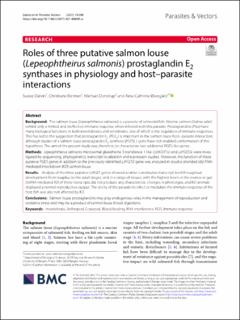| dc.contributor.author | Dalvin, Sussie | |
| dc.contributor.author | Eichner, Christiane | |
| dc.contributor.author | Dondrup, Michael | |
| dc.contributor.author | Øvergård, Aina-Cathrine | |
| dc.date.accessioned | 2021-08-16T08:18:42Z | |
| dc.date.available | 2021-08-16T08:18:42Z | |
| dc.date.created | 2021-04-20T11:31:23Z | |
| dc.date.issued | 2021 | |
| dc.identifier.issn | 1756-3305 | |
| dc.identifier.uri | https://hdl.handle.net/11250/2767898 | |
| dc.description.abstract | Background
The salmon louse (Lepeophtheirus salmonis) is a parasite of salmonid fish. Atlantic salmon (Salmo salar) exhibit only a limited and ineffective immune response when infested with this parasite. Prostaglandins (PGs) have many biological functions in both invertebrates and vertebrates, one of which is the regulation of immune responses. This has led to the suggestion that prostaglandin E2 (PGE2) is important in the salmon louse host–parasite interaction, although studies of a salmon louse prostaglandin E2 synthase (PGES) 2 gene have not enabled conformation of this hypothesis. The aim of the present study was, therefore, to characterize two additional PGES-like genes.
Methods
Lepeophtheirus salmonis microsomal glutathione S-transferase 1 like (LsMGST1L) and LsPGES3L were investigated by sequencing, phylogenetics, transcript localization and expression studies. Moreover, the function of these putative PGES genes in addition to the previously identified LsPGES2 gene was analyzed in double stranded (ds) RNA-mediated knockdown (KD) salmon louse.
Results
Analysis of the three putative LsPGES genes showed a rather constitutive transcript level throughout development from nauplius to the adult stages, and in a range of tissues, with the highest levels in the ovaries or gut. DsRNA-mediated KD of these transcripts did not produce any characteristic changes in phenotype, and KD animals displayed a normal reproductive output. The ability of the parasite to infect or modulate the immune response of the host fish was also not affected by KD.
Conclusions
Salmon louse prostaglandins may play endogenous roles in the management of reproduction and oxidative stress and may be a product of salmon louse blood digestions. | en_US |
| dc.language.iso | eng | en_US |
| dc.publisher | BMC | en_US |
| dc.rights | Navngivelse 4.0 Internasjonal | * |
| dc.rights.uri | http://creativecommons.org/licenses/by/4.0/deed.no | * |
| dc.title | Roles of three putative salmon louse (Lepeophtheirus salmonis) prostaglandin E2 synthases in physiology and host–parasite interactions | en_US |
| dc.type | Journal article | en_US |
| dc.type | Peer reviewed | en_US |
| dc.description.version | publishedVersion | en_US |
| dc.rights.holder | Copyright The Author(s) 2021 | en_US |
| dc.source.articlenumber | 206 | en_US |
| cristin.ispublished | true | |
| cristin.fulltext | original | |
| cristin.qualitycode | 1 | |
| dc.identifier.doi | 10.1186/s13071-021-04690-w | |
| dc.identifier.cristin | 1905273 | |
| dc.source.journal | Parasites & Vectors | en_US |
| dc.relation.project | Norges forskningsråd: 203513 | en_US |
| dc.identifier.citation | Parasites & Vectors. 2021, 14, 206. | en_US |
| dc.source.volume | 14 | en_US |

